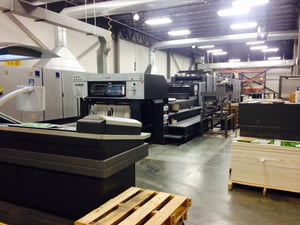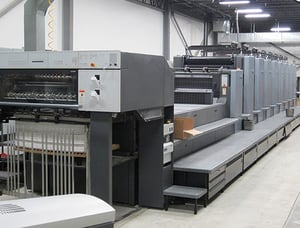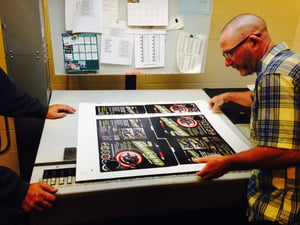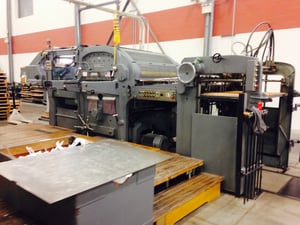I recently went on a press inspection for a packaging project and it got me to thinking that many of our customers probably have no idea how their package is made. To remedy that, I’m writing this post to show you the basics of how your artwork gets onto your box and into your hands.
For this post, I’m going to skip over the creative process (I’ll cover that in another post) for the packaging design of your project and go straight to the printing process. I first need to mention that all our artwork is created on top of a dieline. That dieline is critical to the printing process. It tells the printer the size your package, where the folds are and where the glue is needed. The dieline is made by Catalpha as a layer in the digital artwork.
 Once the digital artwork is sent to the printer, it is sent through their process software which breaks down the package design into separate colors for the printing press to print. In many cases that is Cyan, Magenta, Yellow & Black which is commonly referred to as CMYK or process colors which can print a majority of other colors. Occasionally a client will specify a certain brand color that can be no other color and that is done as an additional PMS color which prints just in that color. All of these colors are then made into printing plates. The plates are then ‘hung’ on the printing press on each color well or unit. One for each color.
Once the digital artwork is sent to the printer, it is sent through their process software which breaks down the package design into separate colors for the printing press to print. In many cases that is Cyan, Magenta, Yellow & Black which is commonly referred to as CMYK or process colors which can print a majority of other colors. Occasionally a client will specify a certain brand color that can be no other color and that is done as an additional PMS color which prints just in that color. All of these colors are then made into printing plates. The plates are then ‘hung’ on the printing press on each color well or unit. One for each color.
 Here’s a picture of a printing press. Yes, they are pretty big AND complex to operate. So, you can imagine the cost to house these monsters and hire a skilled operator to run them efficiently. There are many types of printing presses but for this project, it was run on a 6 unit press. Which means we used 5 of the 6 units, four for C, M, Y and K and one was for an aqueous coating which can be printed ‘in-line’ with the other colors. Not all coatings or varnish can be printed like that, but aqueous coating is possible.
Here’s a picture of a printing press. Yes, they are pretty big AND complex to operate. So, you can imagine the cost to house these monsters and hire a skilled operator to run them efficiently. There are many types of printing presses but for this project, it was run on a 6 unit press. Which means we used 5 of the 6 units, four for C, M, Y and K and one was for an aqueous coating which can be printed ‘in-line’ with the other colors. Not all coatings or varnish can be printed like that, but aqueous coating is possible.
 Once the color is adjusted on press to give us the best possible color, a press sheet is approved and all other sheets are then matched to that approved sheet.
Once the color is adjusted on press to give us the best possible color, a press sheet is approved and all other sheets are then matched to that approved sheet.
From there after an adequate drying time, the sheets are transferred to a diecutter. Here’s a picture of a diecutter press. This is where the package starts to take shape. Previously I mentioned the dieline that is built into our artwork. That die is the turned into a plate that consists of knives formed along the edge of your package as well as a blunt edge to create a score where the folds of the package would lie.
 Each printed sheet is then fed through the diecutter and the end result is a flat piece of stock that is printed and cut to the shape of your package.
Each printed sheet is then fed through the diecutter and the end result is a flat piece of stock that is printed and cut to the shape of your package.
There is one more step and that is to send that printed / cut piece through the folder / gluer. As you can see in this short video, after the machine is set up, your piece can travel through this process where it is folded and glue is applied where needed. Giving you a final ‘flat’ package.
The flat package is then packed and is usually sent directly to the client for insertion of the product. I hope that helps bring some clarity to the package printing process. And a big THANKS to our friends at NuPak Printing for allowing us to show their equipment.


